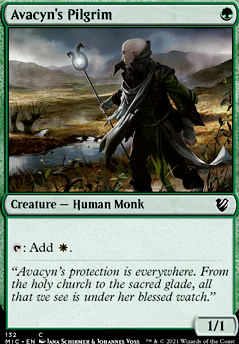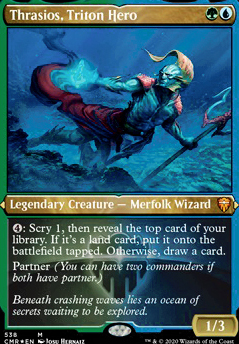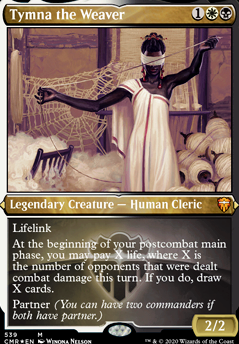Squirrel Nest + Earthcraft
Instructions: Enchant Squirrel Nest to a basic land. Have Earthcraft out. Create a squirrel, then use the squirrel to untap the enchanted land. You'll make infinite squirrels. With
Quest for Renewal
or
Seedborn Muse
, or an untapped
Gaea's Cradle
this combo also creates infinite mana (the latter at sorcery speed; the others at instant speed only). See the Winning with Infinite Mana subsections below for more about what to do there.
Why it's in the deck: It plays friendly with all of our stax. Zur can tutor it by himself. There are very, very, very few effects that actually see play in cEDH that disrupt this line in a convenient way: your opponents need to wipe the board of all your creatures plus one of the two enchantments. It's slow (takes passing the turn to win without the infinite mana shenanigans), but the stax in our deck enables that. You can win with a target on your back if your opponents don't have guns.
Other notes: Earthcraft can also create infinite 4/4 angels with a live
Luminarch Ascension
and either a basic plains with Wild Growth or a basic forest with Utopia Sprawl naming white.
Living Plane Locks with either Elesh Norn or Linvala
Instructions: With either Elesh Norn or Linvala, cast Living Plane. When it resolves, opponents lands will either become -1/-1 creatures (via Elesh Norn) or be unable to activate their mana abilities (via Linvala). Mana dorks will be either dead (via Elesh Norn) or inactive (via Linvala) Add a
Stony Silence
or
Null Rod
to the mix and they'll be really boned-- basically all mana sources except
Carpet of Flowers
will be offline.
Why it's in the deck: It's just one extra slot for a two-card combo, basically. This deck doesn't always just go for straight wins, so it likes drawing into win cons incidentally instead of always tutoring for them, which means we like playing these two-card combos that already synergize with cards we'd otherwise play.
Other notes: I've actually lost once to 1/1 land beats with this lock. Be careful out there.
Freed from the Real Infinite Mana Generation
Instructions: There are three ways to do this. The first and most common way is to attach
Freed from the Real
to
Bloom Tender
, then tap for (at least) UG and untap using the U. By itself, this produces infinite green mana. (See the Winning with Infinite Mana* subsections below for more about what to do with infinite mana.) The second approach is to have a basic Island with
Wild Growth
on it, or a basic forest with
Utopia Sprawl
on it naming blue, can produce infinite green with
Earthcraft
. The third approach is an enchanted forest that taps for U and
Arbor Elf
. For all approaches, be careful if you tap out of blue mana while the untap activated ability is on the stack-- your creature can be killed in response.
Why it's in the deck: Similar to the above: one extra slot for a two-card combo (well, three cards, but you don't need to tutor for Thrasios!). Note that the Wild Growth/Utopia Sprawl + Earthcraft combo is completely incidental.
Additional notes: Freed from the Real is tutorable with
Zur the Enchanter
. The entire 3-card combo with FttR, Earthcraft, and WG/US is tutorable with Zur, too (not including the basic forest or island). If you can help it, when tutoring this off Zur, try to have Thrasios out already so you can draw your deck in response to someone killing the enchanted creature while still in combat.
Trinisphere + Tap-Down Locks
Instructions: If your opponents can't untap more than 2 mana sources (e.g.
Static Orb
),
Opposition
keeps them off 3 mana before they get to play a land, and all spells cost 3 mana with
Trinisphere
, then you've effectively won unless they have
Elvish Spirit Guide
or they have a land that taps for 2+ mana out.
Why it's in the deck: ...It's a stax deck.
Additional notes: This is basically the roll safe meme: "I don't need a wincon if my opponents are staxed out of the game!" It's a bit of a meme, but sometimes that's what happens with this deck. Note that you need to distinguish between "I've almost won with stax" and "I've actually won with stax." Any stax lock that can die to
Nature's Claim
or
Chain of Vapor
and your opponent playing a single land from hand is not a hard lock. You absolutely must use the time your opponents are stax-locked out of the game to draw cards. Don't durdle. Play to the board and dig for your win condition.
Beats
Instructions: Enter the "combat phase" and turn your creatures sideways. This is usually done with
Luminarch Ascension
,
Tendershoot Dryad
, or random creatures +
Elesh Norn, Grand Cenobite
. You can also just do it without any of this stuff if the game is really dragging on long enough.
Why it's in the deck: Well technically speaking the combat phase is part of the game. But the real question is why the 4/4 angel factory and saproling factory are both in the deck. The angel factory is in because it's a compact win con that costs little mana upfront and becomes insanely good in slow games. The saproling factory is a bit more of an upfront investment and dies to creature removal, but damn it is really sweet with
Opposition
and
Aura Shards
and
Tymna the Weaver
and
Chord of Calling
.
Additional notes: Beating in your opponents' faces is never a replacement for either interacting with them or actually winning. Winning with beats is cool but don't get carried away in thinking that this is going to happen on its own. Think of the beats plan as a way to speed up the clock when the stax plan is going well.
Winning with Infinite Mana (at sorcery speed)
This deck doesn't actually literally win with infinite mana the turn you get it. You'll have to pass the turn. Fear not, though, because in almost all situations, your opponents will have zero lands, zero artifacts, zero enchantments. All artifacts and creatures will be unable to tap for mana, all spells will cost at minimum 3 mana, all graveyards will be gone, and you'll have infinite 1/1's. So unless an opponent has
Inkwell Leviathan
and you're in lethal range, there are very very few situations where your opponents can actually win once you do all this.
If it wasn't clear, the infinite mana outlet for this deck is Thrasios. You sink all the mana into Thrasios, and generally speaking for the sorcery speed version you want to just scry over all nonbasic lands as a cushion so you don't lose at your next draw step.
The Bloom Tender and Gaea's Cradle infinite mana lines produce infinite green, which is sufficient for an almost literally unbreakable lock to be set up at sorcery speed. The reason why is simple: activating Thrasios puts your basic lands into play, and green mana casts both
Earthcraft
and various green mana dorks. Green mana dorks can be immediately tapped with Earthcraft to produce other non-green colors off the basics that Thrasios put out. By my counts, you need 7 white mana (and therefore 7 green creatures) to create an effectively impossible-to-break lock.
To get the real lock going, most of the costs are actually green or colorless:
Earthcraft
,
Squirrel Nest
,
Trinisphere
,
Seedborn Muse
,
Null Rod
,
Root Maze
. Then add
Aura Shards
to turn the squirrels into artifact/enchantment destroyers. Add
Linvala, Keeper of Silence
and
Elesh Norn, Grand Cenobite
to remove creatures and make them unable to activate abilities. Turn off graveyards with
Rest in Peace
(so far, this is 6 white mana). Then second to last, while floating a 7th white mana, add
Living Plane
to destroy all lands. (IMPORTANT NOTE: if you cast Living Plane early before producing enough white mana, the lands that enter the battlefield fresh from Thrasios won't be able to tap for mana.) Then last, add
Rule of Law
to the mix, just to be safe.
Winning with Infinite Mana (at instant speed)
Instant speed infinite mana lines occur when you're able to untap all the squirrels during someone else's untap step. As long as you have Thrasios out and basic lands in your deck, this is sufficient to produce all your colors, but it can only cast instants. If you've already cast a
Brainstorm
(or, frankly, even if you have), be careful that you don't accidentally draw a creature you'd want to flash in with
Chord of Calling
. The way to best ensure this doesn't happen is to not scry away cards with Thrasios, until you see a creature you'd want to cast at instant speed, then scry that one particular creature to the bottom. If you use the scry before this, you might accidentally draw the creature.
Unfortunately, there's no way to get a really solid lock on your opponents at instant speed. Between
Swan Song
,
Swords to Plowshares
,
Abrupt Decay
,
Assassin's Trophy
,
Mental Misstep
,
Containment Priest
,
Aven Mindcensor
, and
Chord of Calling
, plus whatever stax pieces you already have out, the hope is that you should be able to hold off opponents for just one more turn. And usually, this is in fact what happens.









